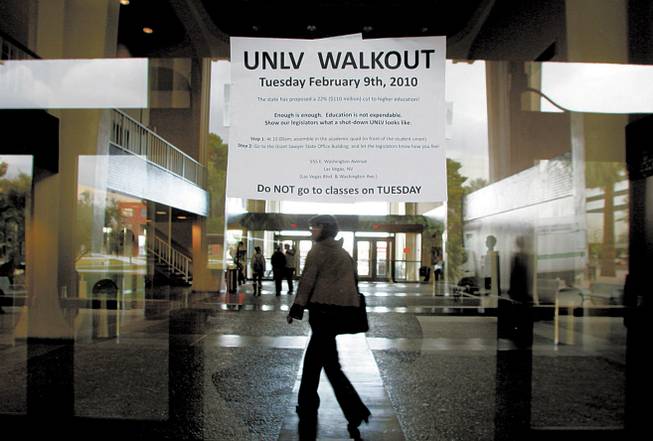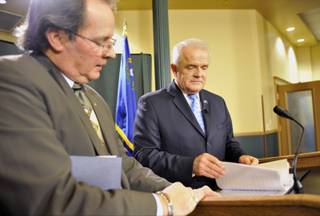
A flier advertises a student walkout at UNLV to protest proposed budget cuts. Organizers are asking students to gather at 10 a.m.
Tuesday, Feb. 9, 2010 | 2 a.m.
Reader poll
State of the State
Gov. Jim Gibbons gave an emergency State of the State address at 6 p.m. Monday, Feb. 8. Video is courtesy KVBC Channel 3.
Sun Archives
- Governor plans emergency address on Nevada budget (2-7-10)
- Governor’s speech will lay out state’s budget problems (2-7-10)
- State budget comes up $800 million short (1-22-10)
- Forecast: Economy will begin to rebound in mid-2011 (1-22-10)
- Gibbons’ no-talk order further divides branches (1-22-10)
- Special session may require help of state Supreme Court (1-10-10)
Sun Coverage
Taking a page from earlier generations of Southern Nevada campus activists, UNLV students plan a walkout today to oppose Gov. Jim Gibbons’ proposed budget cuts.
They may have to dust off their protest manual.
The Rebels showed a rebellious streak in the 1950s, ’60s and ’70s, when they helped change the course of local elections, forced the university to abandon unpopular policies and complained about lack of parity with the University of Nevada in Reno.
The historic events also helped shape students who later became Nevada’s political and community leaders, including former congressman James Bilbray, Rep. Shelley Berkley, state Sen. Bob Coffin and District Judge Lee Gates.
They took on broader issues, too, such as civil rights and opposition to the Vietnam War.
And about 40 years ago they complained about budget cuts.
It was 1969, and students at Nevada Southern University — later to become UNLV — built an on-campus shantytown out of lumber scraps and oil drums, taking up residence to protest a lack of state funding for higher education. Sympathetic professors taught their classes at the makeshift “Education City.”
But in the 1980s, with money plentiful, “The students went to sleep,” said UNLV professor Gene Moehring, who has written a book on UNLV’s first 50 years. “The ’90s weren’t much better.”
The students “woke up two years ago” when the state’s plummeting economic outlook forced steep cuts to higher education, Moehring said.
Still, Moehring hasn’t seen the same level of outrage among students that was prevalent in the university’s early days. The university has done a good job protecting the quality of education despite reduced funding, and many students haven’t been directly affected, he said.
“If there were to be cuts that would obviously hurt them, that would draw more people out to protest,” Moehring said.
Key to that, he said, is for students to realize that major pay cuts for faculty will likely push top professors into leaving, which will hurt the value of a UNLV degree. And if the Nevada System of Higher Education becomes the first such entity in the nation to declare a financial emergency, that’s “going to give us all a black eye. It will be hard to hire good professors to come here.”
Organizers of today’s protest are calling on students to gather at the Student Union at 10 a.m. and car-pool to the Legislature’s Interim Finance Committee meeting at the Sawyer State Office Building on Washington Avenue.
Nearly a thousand people have indicated via Facebook that they plan to participate, said Kyle George, vice president of UNLV’s Graduate and Professional Student Association, which voted to support the protest. Student groups at College of Southern Nevada and Nevada State College also support the effort and are expected to take part, George said.
Other organizers of the protest include Adam Cronis, the university’s student body president, and Jessica Lucero, president of the Graduate and Professional Students Association.
Not surprisingly, they’re finding support from faculty.
“UNLV students are some of the most significant stakeholders in this disaster,” said professor John Filler, Faculty Senate chairman. “As future leaders of the state, I am very proud of the fact that they are willing to take a public stand for UNLV. I only hope that the members of the Nevada Legislature also realize how precious this university is to the future of our state and take the affirmative action necessary save higher education.”
A prior commitment will keep him off campus today, Filler said, or else he would take part in the walkout and protest.
He said he hoped his colleagues would participate. “It’s their choice. Obviously, they have to behave responsibly. There are some classes you can’t walk out on, but I think the students understand that.”
In a memo to faculty, UNLV Provost Michael Bowers said he was proud of the campus for expressing its support for higher education, but cautioned them “to be appropriately accountable” for their actions as students decide whether to miss classes and instructors decide whether to excuse them.
UNLV professor Greg Brown, president of the university’s Faculty Alliance, said he think his colleagues “understand and sympathize with the students’ willingness to take risks with their grades now to try to preserve their chances for an education in the future. I’m impressed that the students understand what is at stake for all of us.”
The student walkout should serve as a watershed moment, Brown said.
“Everyone in the state will have to examine their consciences, and decide whether they really believe that the rhetoric of the past is sufficient for our future,” Brown said. “These students seem to have a clear sense already. I wonder not about whether faculty agree but about the rest of the community. Will business leaders, legislators, alumni and others be there, in person or in spirit? It’s their future, too.”
George, who helped organize rallies and protests to prior budget cuts, said the message needs to get to the public that cutting higher ed will only shift the burden to other public agencies.
Higher unemployment rates are reflected as indirect costs to health and human services, public safety and the state’s corrections system, George said. At the same time, economists say states typically see a 4-to-1 return on dollars invested in education.
The cuts to education funding in Nevada are “beyond unfortunate — it’s just unacceptable,” Rep. Dina Titus, D-Nev., said.
Titus, who taught political science at UNLV for 30 years, said she commended the university students for getting involved, even though “usually walkouts are to influence the administration, not the Legislature. The administration is already on board.”
But the level of student participation will give UNLV President Neal Smatresk “an idea of how much support he does have going forward,” Titus said. “Symbolically, that’s a good thing.”
If she were in front of a class at UNLV during today’s protest, Titus said she wouldn’t want her students to leave and miss out on instructional time.
“Maybe we could walk out together,” Titus said. “We could learn a political lesson by participating.”


Join the Discussion:
Check this out for a full explanation of our conversion to the LiveFyre commenting system and instructions on how to sign up for an account.
Full comments policy